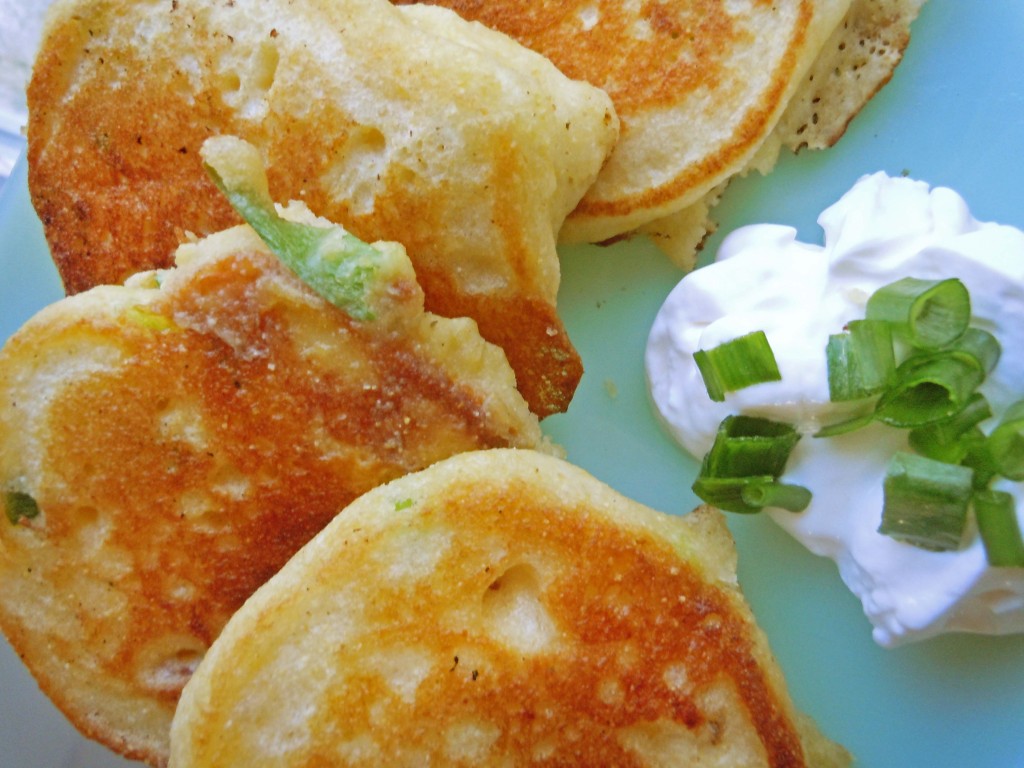[W]hen we travel, we meet ourselves head-on. Outside of our regular routines and familiar environments, we can self-startle and see sides of us we don’t always see.
Like my stomach…I saw it walking ahead of me in downtown Atlanta, sticking straight out, fuller than I had ever seen it, proud and distended. Following (or should I say leading) a dinner with an all-you-can eat salad buffet, fried green tomato appetizer and a platter of catfish. The meal was part of the final stretch of a weeklong visit in the South, where I had eaten vigorously in industrial-size proportions. I had consumed my weight in biscuits, which accompanied every meal. And at one eatery, along with the daily bread of biscuit, came a curious creature called a hoecake.
 I was not completely unfamiliar with a hoecake, but had never eaten one. This Georgia hoecake was soft and tender and pale, a cornmeal pancake of a deceptively demure diameter. The hoecakes — as well as all the delicious and unavoidable foods of the South — weigh down on you later, not painfully, mind you, but just a gentle, dense nudge that yes, you overindulged, you had say in the matter, but, what the hell, you were in the South.
I was not completely unfamiliar with a hoecake, but had never eaten one. This Georgia hoecake was soft and tender and pale, a cornmeal pancake of a deceptively demure diameter. The hoecakes — as well as all the delicious and unavoidable foods of the South — weigh down on you later, not painfully, mind you, but just a gentle, dense nudge that yes, you overindulged, you had say in the matter, but, what the hell, you were in the South.
I’ve returned and reformed, somewhat. I’ve taken a breather from my favorite bread, the biscuit (but now that National Biscuit Month is here, I may not be able to hold out much longer). I’ve worked out more (taken the biscuits for a run or two). But the South haunts me still. It’s the spirit and the history I can’t seem to let go of, as well as the lingering irresistible smell of the fat and the fried. And a hoecake, who knew such an old timey thing still has a presence on the restaurant scene?
What makes a hoecake stay in my mind mostly is not what it is, but its name. What is the “hoe†in hoecakes? Beyond the jokes of wily and unscrupulous women (and men), a hoe is an instrument used to chop at the earth, break apart soil and unwanted plant life in one’s garden or field. Was a cake ever cooked on such, as legend and history speculate? It
confounds the mind, but that’s what makes it so intriguing. The hoecake, aka corn pone, ash cake, johnnycake, shawnee cake, etc. may have been so named because it was in fact baked on the removable blade of a hoe (which, looking at this old version of a cotton hoe blade seems do-able: ), or “hoecake†could have come from the Native American word “hokeg.†I love the fact that there is more than one possibility of origin. Nothing is certain, except for the general notion that a hoecake is in fact a cornbread (made with hot water by most suggestions) cooked on a griddle of some type.
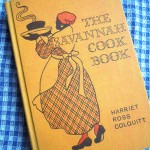 The older recipes for hoecakes, one of which comes from Harriet Ross Colquitt’s “The Savannah Cook
The older recipes for hoecakes, one of which comes from Harriet Ross Colquitt’s “The Savannah Cook
Book†(1933), left me dubious to the outcome. In general, they boiled down to a fried cornmeal mush. Still, I held to the possibility that this might taste OK, considering my grandmother whipped up this version for her children; my father remembers them fondly. Simply (and I mean simply) put, these cakes are cornmeal and a little salt, soaked in hot water or milk, then fried in oil.
My mother, who is a No. 1 fan of any cornmeal pancake, was extra doubtful, particularly since she had tried to re-create the cornmeal mush version. “They don’t hold together!†she declared. True, an egg component would most likely bind the batter better. But I would try, anyway.
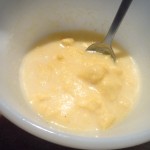 There were no specific measurements in Colquitt’s recipe. How very Old School. I decided to mix milk and water to make a cup and a half, then heat to boiling and pour over about 1/2 teaspoon of salt mixed with approximately 3/4 cup finely ground cornmeal. I let this soak up for about an hour to a nice mushy consistency (slightly soupier than mashed potatoes). In fashioning the cakes, I followed the recipe’s suggestion of making them small — 2 to 3 teaspoons of batter per cake (here I decided might have been my mother’s error, a bigger cake would be harder to manage).
There were no specific measurements in Colquitt’s recipe. How very Old School. I decided to mix milk and water to make a cup and a half, then heat to boiling and pour over about 1/2 teaspoon of salt mixed with approximately 3/4 cup finely ground cornmeal. I let this soak up for about an hour to a nice mushy consistency (slightly soupier than mashed potatoes). In fashioning the cakes, I followed the recipe’s suggestion of making them small — 2 to 3 teaspoons of batter per cake (here I decided might have been my mother’s error, a bigger cake would be harder to manage).
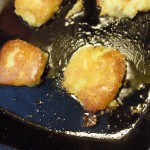 The cakes were spread in a good amount of hot oil in a skillet (cast iron or nonstick). Their sizzling, corny aroma made me consider the Depression-era cooks conjuring a meal from three basic ingredients…I felt warmly tied to the past. The first batch of
The cakes were spread in a good amount of hot oil in a skillet (cast iron or nonstick). Their sizzling, corny aroma made me consider the Depression-era cooks conjuring a meal from three basic ingredients…I felt warmly tied to the past. The first batch of
cakes (as with many pancakes, too), was a bit of a tester. These cakes need to cook awhile, several minutes, or flipping them, small as they may be, results in a de-structuring flop. They do fall apart, unless you let them cook adequately to develop a stabilizing crust. Also using two small spatulas — one to help push the cake onto the other — helps turn the cake more successfully.
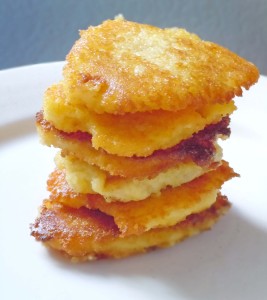 Still doubtful about the taste, I sampled the cakes. Crunchy exterior, creamy polenta-like interior, full corn flavor. They were delicious! With a little honey, extra good. I was well- pleased. And certainly connected to the home cooks who came before.
Still doubtful about the taste, I sampled the cakes. Crunchy exterior, creamy polenta-like interior, full corn flavor. They were delicious! With a little honey, extra good. I was well- pleased. And certainly connected to the home cooks who came before.
Hoe Cake
From “The Savannah Cook Book†by Harriet Ross Colquitt (1933) Makes about 10 to 12 2-inch cakes
Pour enough scalding water, or milk, on salted corn meal to make it rather moist. Let it stand one hour or longer. Put two or three teaspoons of this on hot, greased griddle, smooth it out to make cake about one-half inch thick, and let cook. When one side is done, turn it over and brown the other.
Serve very hot for breakfast
In looking around the Web at hoecake recipes, one search turned up a more modern version that made me stop in my tracks. Bacon and Scallion Hoecakes, from the Garden and Gun magazine website. 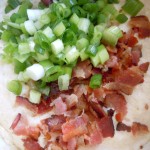 The recipe comes from Banks White, chef at Five restaurant in Berkeley, CA, and is a more traditional pancake-style, with self-rising flour and cornmeal, buttermilk, eggs and, whoa, bacon fat in the cakes as well as in the skillet you fry them upon!
The recipe comes from Banks White, chef at Five restaurant in Berkeley, CA, and is a more traditional pancake-style, with self-rising flour and cornmeal, buttermilk, eggs and, whoa, bacon fat in the cakes as well as in the skillet you fry them upon!
What a great combination of flavors with the spring onions and crumbled bacon. What’s not to like, although if you wanted something plain, you could easily leave these out for a morning hoecake, but why? The end result is a 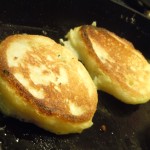 delicately flavored, light-as-air-cake. Onion ring-meets-bacpn-and-pancakes. The cakes could be served as an appetizer or savory side to a lunch or dinner (some sour cream makes a great condiment). But they can also be breakfast. There were leftovers, and I heated them and ate them with jam. The South is closer than the length of a hoe.
delicately flavored, light-as-air-cake. Onion ring-meets-bacpn-and-pancakes. The cakes could be served as an appetizer or savory side to a lunch or dinner (some sour cream makes a great condiment). But they can also be breakfast. There were leftovers, and I heated them and ate them with jam. The South is closer than the length of a hoe.
Bacon Scallion Hoecakes
From Garden and Gun
(Makes 14 large, or 28 silver-dollar, cakes) 1 cup self-rising flour
1 cup fine yellow cornmeal
2 tsp. baking powder
1â„2 tsp. salt
1â„2 tbsp. sugar
2∕3 cup buttermilk
1∕3 cup water
Scant 1â„4 cup bacon fat
1∕3 cup crème fraîche or sour cream
2 eggs
1∕3 cup scallions, thinly sliced
1â„4 cup crisp bacon, finely chopped
Canola oil, combined with some bacon fat if desired
In a medium bowl, whisk together flour, cornmeal, baking powder, salt, and sugar.

In another small bowl, combine buttermilk, water, bacon fat,
and crème fraîche or sour cream. Blend well. Add eggs, and mix until just combined.
Pour liquid into dry ingredients, and mix just until a thick batter has formed. Stir in scallions and bacon. To keep the hoecakes tender, avoid overmixing.
Heat oil and bacon fat in a cast-iron or other heavy skillet over medium to medium-high heat. Use about an eighth of a cup of batter for smaller cakes, or a quarter cup for larger ones. Cook them as you would pancakes, allowing them to fry on one side for about three minutes or until crisp and golden brown. Flip and cook for another couple of minutes. Replenish oil as needed, to maintain a generous film in the pan.
Batter will keep for a couple of days tightly covered in the refrigerator. If it seems too thick after storing, stir in a bit more buttermilk or water.